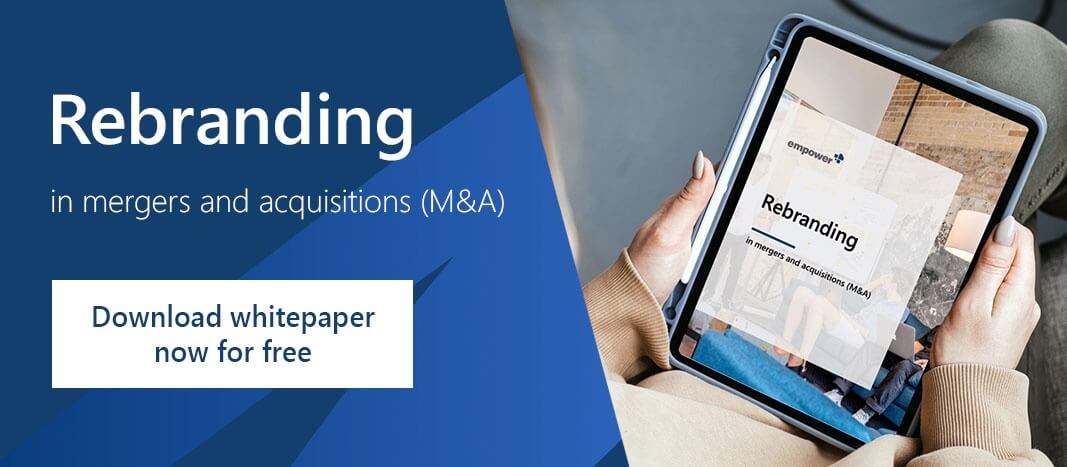Rebranding is often a monumental task even on a small scale. But how does such an endeavor even work on a global scale? Andersen Consulting led the way around the new millennium, implementing their rebranding globally after dividing the company. Let’s take a closer look at their strategy and what takeaways you can learn for your own global rebranding.
- 3 pillars for your global rebranding strategy
- Global rebranding strategy
- Restructuring supported by the global branding strategy
- Repositioning as part of the global rebranding strategy
- Drive your global rebranding with empower®
3 pillars for your global rebranding strategy
Rebranding involves much more than just a new logo on documents and products. Companies can and should also reflect on their market position and corporate structure.

Accenture achieved their global rebranding based on 3 pillars: Rebranding, Restructuring and Repositioning. To manage the project, they brought on board branding experts James E. Murphy as Global Managing Director for Marketing and Communications, and Teresa L. Poggenpohl as Partner and Director of Global Brand, Advertising and Research.
The company had just 147 days to complete the rebranding, during which they had to lead 55 teams and 70,000 employees in 47 countries through the rebranding process. Once the rebranding was in place, it was successfully launched in just 67 days. Projects of this size typically take more than 120 days. We explain how Accenture achieved this impressive timeline in the three following sections.
Global rebranding strategy
As discussed in more detail in our article on implementing brand style guides, involving employees in branding is an important step toward brand compliance.
To develop the company’s new brand identity, Accenture consulted its employees. Every employee could give their input and suggest names for the new brand.

The consulting firm Landor advised on the new name. They helped Accenture select the perfect one from 5,000 suggestions. This was followed by research into the pronunciation of the name in several languages, as well as cultural sensitivities regarding the name, its meaning, and its pronunciation. They also investigated whether there was already a company or patent using the name in the respective countries.
Existing business-to-employee portals were used to share the new branding. Accenture also hosted company events to introduce the new branding and build enthusiasm around the new name and brand.
Once the new name was in place, the new logo was developed and introduced in a phase-in/phase-out strategy. For 90 days, the new name was intensively promoted to customers and the public until the old name was completely retired. Push methods such as personalized gift packages and brochures to existing clients were used, as well as pull methods such as Superbowl ads and sponsorship agreements.

Reactions were very extensively monitored and regularly evaluated. The rebranding team confirmed that the name change was ingrained in the minds of the public.
Takeaways:
- For successful implementation, involve employees in developing the global rebranding strategy.
- Build enthusiasm for the new branding through events.
- Communicate name changes to existing clientele in a personalized and attention-grabbing way.
- Inform the public about changes.
Restructuring supported by the global rebranding strategy
As part of the global rebranding strategy, those responsible also looked at the structure of the company. Ultimately, the ownership structure of the company was changed and the business became a stock corporation. However, only 12% of the shares were made available to the public.
At the same time, there were stronger guidelines that made it more difficult to leave the company as a partner. To retain staff, a “Creative Talent Retention Program” was launched as an employer branding strategy. Unlike other firms that sought to terminate employees in the most cost-efficient way, Accenture opted for a more compassionate approach. For example, the program allowed employees to take a partially paid sabbatical after a certain number of years with the company. That solved the company’s overstaffing issues while giving employees the opportunity to recover from the work environment and then return to the company refreshed.

Employees at both senior level and lower positions could take advantage of this offer. There were no specifications as to how the sabbatical period was to be used other than employment for the competition was excluded. Afterwards, the employee was reinstated in the company.
Initially, this program was only offered in the United States. But as management saw success with the program, they expanded it globally.
Takeaways:
- As part of the global rebranding strategy, revisit the corporate structure and make changes as necessary.
- Employer branding leads to more positive brand perceptions even during active rebranding.
Repositioning as part of the global rebranding strategy

Let’s move on to the third and final pillar of Accenture’s global rebranding strategy.
The company decided to expand its business and use rebranding to expand its market position. “Consulting” was too specific a positioning for Accenture. The rebranding provided a perfect opportunity to adjust and optimize its placement. The rebranding better communicated and implemented the company’s new vision as a market maker. The new positioning included outsourcing, partnerships, venture capital, and technical capabilities in addition to traditional business consulting, rather than being limited to just “consulting.”
Takeaways:
- Take a close look at the company’s vision and adjust it if necessary.
- Evaluate the company’s positioning in the market and consider repositioning
Drive your global rebranding with empower®
The faster, the better. This is true whenever implementing any rebranding. At the beginning of this article, we mentioned that Accenture’s rebranding was implemented in 67 days.
Our client Merck took just 6 weeks to implement their new branding company-wide, a mere 42 days. But how did they do it? Quite simply, Merck used our empower® Brand Control solution to streamline their rebranding in Microsoft Office.
Our practical Microsoft Office add-ins ensure that your branding is embedded directly in the Office applications. Your employees automatically apply the new design without having to spend time formatting their documents. Plus, new designs can be applied to existing presentations with just a few clicks.
Contact us to learn how our solution can make your global rebranding a breeze!

You May Also Like
Related articles

Rebranding strategy – what you should consider

Rebranding in Mergers & Acquisitions

